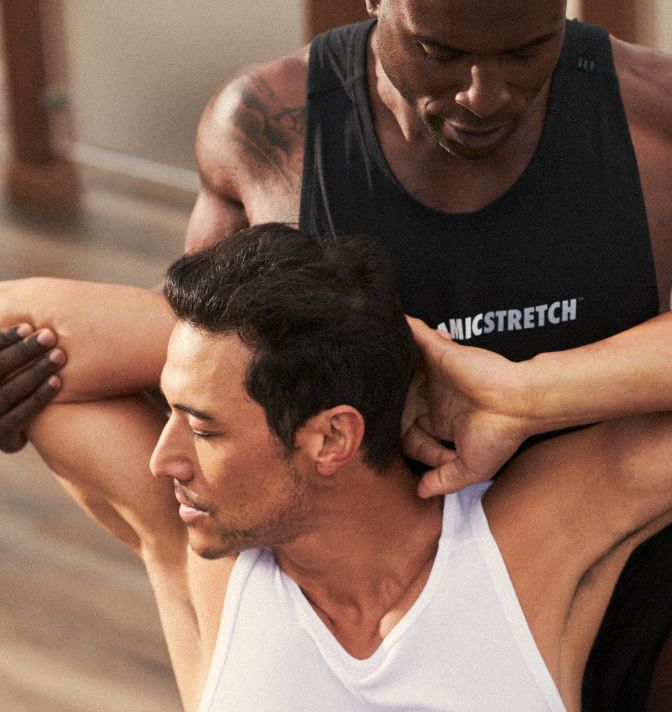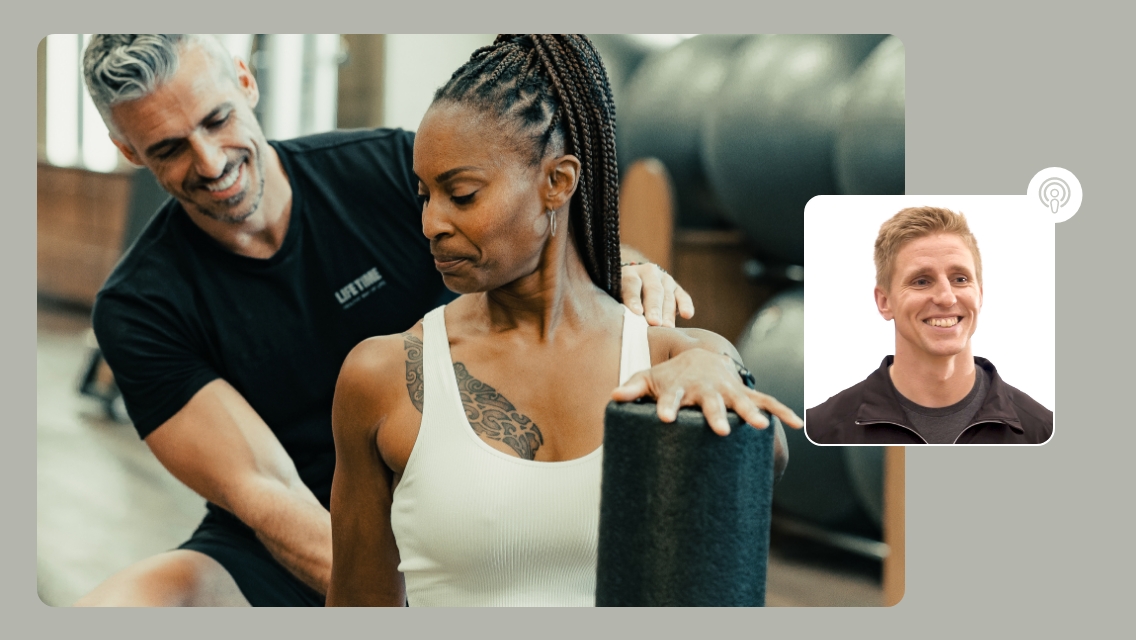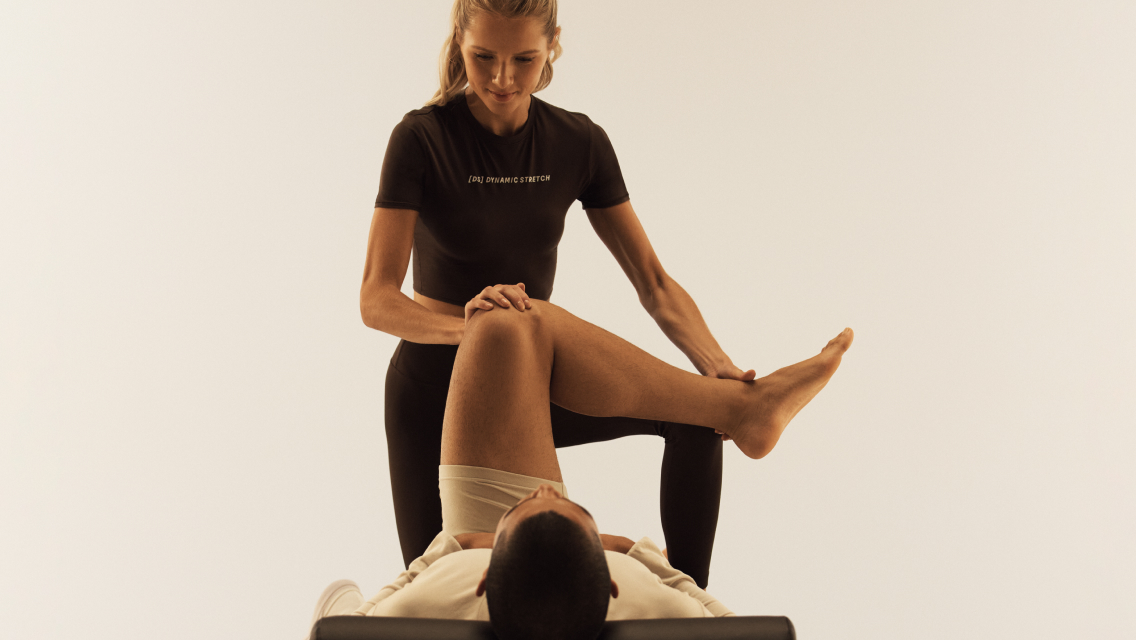“Be sure to stretch!” is something you’ve probably heard countless times before or after participating in any type of exercise program or class. But how often do you actually follow that advice?
“I’ve never heard anyone say, ‘I stretch too much,’” says Danny King, Master Trainer and manager of performance and recovery for Life Time. “Stretching your muscles regularly is important, especially if you find yourself saying, ‘I don’t move as well as I used to,’ or you experience aches, pains, soreness, or stiffness.”
Whether you’re someone who needs a little extra accountability when it comes to stretching, you have specific flexibility or mobility issues, an injury to consider, or you simply want to learn how to stretch and feel better, Dynamic Stretch can provide some much-needed support. This one-on-one, hands-on assisted stretching session is individualized — with a stretch specialist customizing the experience based on your unique body and goals. (Dynamic Stretch sessions are now available to book in the Life Time app.)
To learn more about Dynamic Stretch at Life Time, we asked King, one of the program’s co-creators, to answer a few common questions.
Life Time Editorial | What is Dynamic Stretch? What can I expect in a session?
Danny King | A Dynamic Stretch session is a hands-on, 25- or 50-minute assisted-stretch session. We’ve been doing this for several years at Life Time, but we wanted to make it more visible and accessible for our members. During a typical session, a Dynamic Stretch Specialist will lead you through a series of assisted stretches for your full body while you’re lying or sitting on a training table.
The session can take several directions depending on your goals. Your stretch specialist will ask you questions about what you’re looking for and about any injuries or limitations you might have. They may also start with a movement assessment to see how you move and identify any areas of stiffness or tightness.
From there, your specialist will bring your muscles through a range of motion, often into positions you’re likely not doing or aren’t able to do on your own. The first session is all about discovery. We’re going to work on areas that are most commonly tight for people and we’re seeking out the areas that hold extra stiffness.
As you continue with more sessions, your specialist will get to know you and be able to further customize your movements and stretches to your training and activity regimen and to reach your specific goals.
LTE | How do I know whether to book a 25-minute session or 50-minute session?
DK | I’m a huge fan of adding on the 25-minute session to the workouts you’re currently doing. For example, you can take a class and then go get stretched out in a Dynamic Stretch session. You’ll still get in and out of the club in well under two hours.
The 50-minute session works best for someone who is really seeking stress relief and relaxation — or if you have more specific goals with your flexibility.
LTE | What certifications does a Dynamic Stretch Specialist have?
DK | Our Dynamic Stretch Specialists are incredible fitness professionals who have studied anatomy and physiology and are certified in several areas. We also built our own Life Time certification around the science of flexibility and a variety of stretching techniques that all of our specialists have.
LTE | What are the overall benefits of a Dynamic Stretch session?
DK | The better you feel, the more likely you are to move — to take more steps, to join that workout class, and to keep up that exercise routine. Dynamic Stretch helps improve your recovery and range of motion, so you have less aches, pains, and soreness and can do more in your workouts and in everyday life.
For those who need accountability with stretching, scheduling an assisted-stretch session is a way to make sure your body is getting the recovery it needs.
Dynamic Stretch is a low-intimidation way to get started when you’re just beginning an exercise routine. I always advise starting with movement that makes you feel good, and that can often be as simple as stretching. And soon, your body will likely want to move more.
LTE | Is there a difference between Dynamic Stretch and dynamic stretching?
DK | Dynamic Stretch is the branded name at Life Time for these one-on-one, assisted stretch sessions with our stretch therapists. This is distinctly different from dynamic stretching, which is a general term used in the fitness industry to describe a style of stretching that involves powerful, repeated movements performed with an extended range of motion.
We launched Dynamic Personal Training, Life Time’s unique approach to personal training, last year. Dynamic Stretch is our next extension of that umbrella “dynamic” brand. You will see Life Time continue to enhance this portfolio of products and offerings in the time to come.
LTE | Why is assisted stretching better than stretching on my own or in a yoga class?
DK | There are some unique advantages to assisted stretching. When you stretch on your own, your body must do more of the work. Instead of solely focusing on your hamstring, for example, other muscle groups are brought into the mix to help make that stretch happen.
With assisted stretch, you can relax everything except the muscle you’re targeting, which results in a much deeper, more effective stretch, as well as more relaxation for the entire body.
We’re all inherently trying to avoid pain, so when you’re stretching on your own, your body might say, “I don’t love that feeling, let me pull back a little,” and you miss out on getting the proper stretch in the right areas. When a trainer is assisting you, they can feel those areas of tightness or restriction and hold you in place and make sure you’re stretching them correctly.
LTE | Do you have recommendations for how to fit a Dynamic Stretch session into my workout routine?
DK | Your Dynamic Stretch Specialist will customize your session based on when you’re doing it and what you’re looking to get out of it. For example, you might start with one session per week and then work with your specialist to figure out the right cadence for your goals. I often recommend booking a 25-minute session either before or after your workout. Most people are choosing after because it’s a great way to help cool your body down.
If you choose to book a session pre-workout, we can focus on more active stretches to get the muscles you’re looking to target turned on and ready to work. This is especially helpful for runners or those doing heavy lifting as a warmup before those more intense movements.





